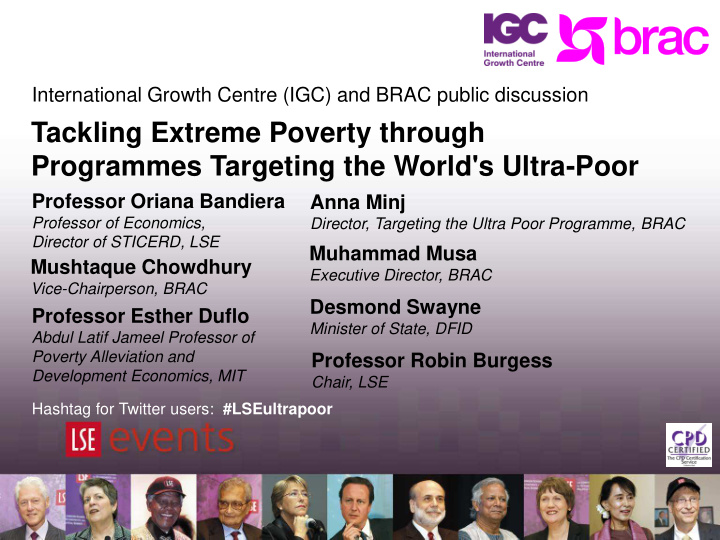



International Growth Centre (IGC) and BRAC public discussion Tackling Extreme Poverty through Programmes Targeting the World's Ultra-Poor Professor Oriana Bandiera Anna Minj Professor of Economics, Director, Targeting the Ultra Poor Programme, BRAC Director of STICERD, LSE Muhammad Musa Mushtaque Chowdhury Executive Director, BRAC Vice-Chairperson, BRAC Desmond Swayne Professor Esther Duflo Minister of State, DFID Abdul Latif Jameel Professor of Poverty Alleviation and Professor Robin Burgess Development Economics, MIT Chair, LSE Hashtag for Twitter users: #LSEultrapoor
BRAC’s Ultra-Poor Program Results from a long-run evaluation in Bangladesh Oriana Bandiera (LSE)
the context • women labor markets in Bangladeshi villages where BRAC TUP operates – 1309 poor villages – 23,000 HHs from different wealth classes
women only do 3 jobs Other Livestock rearing (cows/goats) Share of hours Casual Wage Labor: Domestic Maid Casual Wage Labor: Agriculture Branch
hourly earnings are lower in casual jobs Livestock rearing (cows/goats) Hourly earnings, by activity Casual Wage Labor: Agriculture Casual Wage Labor: Domestic Maid Branch
only the poor do casual jobs Other Livestock rearing (cows/goats) Share of hours Casual Wage Labor: Domestic Maid Casual Wage Labor: Agriculture Ultra poor Upper class Near poor Middle class
Poverty trap? no productive assets can’t can only afford do casual assets jobs low pay, low low income demand
BRAC’s TUP aims to break the trap • Eligible: poor women, identified by the communities, verified by BRAC employees – On avge, 6 women per community (7% of HHs) are eligible • Asset menu: livestock, small crafts, small retail.. • Almost all choose a livestock combination • Value of transfer (9500TK= 140USD) – 1X yearly PCE; 2X yearly earnings; 9X savings • Commit to retain it for 2 years, free to sell after that • Asset specific training - intensive over first year
Evaluation strategy • Randomise the programme roll-out across 40 BRAC branch offices (1309 communities) in the poorest areas of the country – 20 treated in 2007, 20 in 2011 • Beneficiaries + all other poor + a sample of other wealth classes surveyed in 07,09, 11,14 • Final sample: 6732 eligible beneficiaries & 16,297 HHs from other classes
TUP transforms job choice.. Programme impacts after 4 years 600 160 500 140 400 120 300 100 200 80 100 60 0 40 Hours devoted to Hours devoted to Hours devoted to Total hours worked -100 livestock rearing agricultural labour maid work 20 -200 0 -300 Earnings (USD)
this increases consumption & savings Programme impacts after 4 years (USD -PPP) 120 100 80 60 40 20 0 Expenditure on durables Expenditure on non-durables Household cash savings per adult equivalent
and leads to further asset accumulation Programme impacts after 4 years (USD PPP) 700 600 500 400 300 200 100 0 Value of cows Value of land Value of other business assets
benefit/cost ratio is 5.4 costs benefits
internal rate of return is high 22% on average positive for larger than 22% larger than 5% almost all for a large for most beneficiaries minority
Effects are sustained after 7 years
Expenditure on non-durables Yearly changes in expenditure on non-durables after 2, 4 and 7 years (USD) 1600 1400 1200 1000 800 600 400 200 0 2007-09 2007-11 2007-14 -200 -400 Treatment Control
Expenditure on durables Yearly changes in expenditure on durables after 2, 4 and 7 years (USD) 140 120 100 80 60 40 20 0 2007-09 2007-11 2007-14 Treatment Control
Productive assets Yearly changes in productive assets after 2, 4 and 7 years (USD) 1800 1600 1400 1200 1000 800 600 400 200 0 2007-09 2007-11 2007-14 Treatment Control
Access to land Yearly changes in share with access to land after 2, 4 and 7 years 0.35 0.3 0.25 0.2 0.15 0.1 0.05 0 2007-09 2007-11 2007-14 -0.05 Treatment Control
BRAC TUP breaks the poverty trap no productive assets combine can’t can only labor with accumulate afford do casual assets in more assets assets jobs small businesses higher hourly low pay, higher low low pay, regular income income demand employment
International Growth Centre (IGC) and BRAC public discussion Tackling Extreme Poverty through Programmes Targeting the World's Ultra-Poor Professor Oriana Bandiera Anna Minj Professor of Economics, Director, Targeting the Ultra Poor Programme, BRAC Director of STICERD, LSE Muhammad Musa Mushtaque Chowdhury Executive Director, BRAC Vice-Chairperson, BRAC Desmond Swayne Professor Esther Duflo Minister of State, DFID Abdul Latif Jameel Professor of Poverty Alleviation and Professor Robin Burgess Development Economics, MIT Chair, LSE Hashtag for Twitter users: #LSEultrapoor
Recommend
More recommend